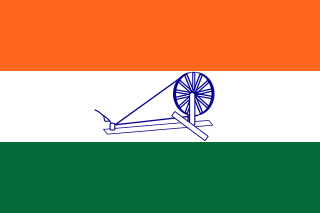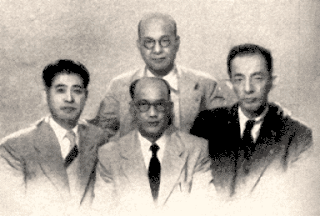
The Indian National Army was a collaborationist armed unit of Indian collaborators that fought under the command of the Japanese Empire. It was founded by Mohan Singh in September 1942 in Southeast Asia during World War II.

Subhas Chandra Bose was an Indian nationalist whose defiance of British authority in India made him a hero among many Indians, but his wartime alliances with Nazi Germany and Imperial Japan left a legacy vexed by authoritarianism, anti-Semitism, and military failure. The honorific 'Netaji' was first applied to Bose in Germany in early 1942—by the Indian soldiers of the Indische Legion and by the German and Indian officials in the Special Bureau for India in Berlin. It is now used throughout India.

During the Second World War (1939–1945), India was a part of the British Empire. British India officially declared war on Nazi Germany in September 1939. India, as a part of the Allied Nations, sent over two and a half million soldiers to fight under British command against the Axis powers. India was also used as the base for American operations in support of China in the China Burma India Theater.

The Provisional Government of Free India or, more simply, Azad Hind, was a short-lived Japanese-controlled provisional government in India. It was established in Japanese occupied Singapore during World War II in October 1943 and has been considered a puppet state of the Empire of Japan.

Netaji Subhas Chandra Bose: The Forgotten Hero is a 2004 Indian epic biographical war film, written and directed by Shyam Benegal. The film starred an ensemble cast of Sachin Khedekar, Kulbhushan Kharbanda, Rajit Kapur, Arif Zakaria, and Divya Dutta, among others. The film depicts the life of the Indian Independence leader Subhas Chandra Bose in Nazi Germany: 1941–1943, and in Japanese-occupied Asia 1943–1945, and the events leading to the formation of Azad Hind Fauj.

Indian nationalist leader Subhas Chandra Bose died on 18 August 1945 from third-degree burns sustained after the bomber in which he was being transported as a guest of Lieutenant General Tsunamasa Shidei of the Imperial Japanese Kwantung Army crashed upon take off from the airport in Taihoku, Japanese Formosa, now Taipei, Taiwan. The chief pilot, copilot, and General Shidei were instantly killed.
The Indian Independence League was a political organisation operated from the 1920s to the 1940s to organise those living outside British India into seeking the removal of British colonial rule over the region. Founded by Indian nationalists, its activities were conducted in various parts of Southeast Asia. It included Indian expatriates, and later, Indian nationalists in-exile under Japanese occupation following Japan's successful Malayan Campaign during the first part of the Second World War. During the Japanese Occupation of Malaya, the Japanese encouraged Indians in Malaya to join the League.

The Indian National Army trials was the British Indian trial by court-martial of a number of officers of the Indian National Army (INA) between November 1945 and May 1946, on various charges of treason, torture, murder and abetment to murder, during the Second World War.

Subbier Appadurai Ayer was the Minister for Publicity and Propaganda in Subhas Chandra Bose's Azad Hind Government between 1943 and 1945, and later a key defence witness during the first of the INA trials. Ayer had travelled to Bangkok in November 1940 as a Special correspondent for Reuters before joining the Indian Independence League. In October 1943, Ayer was appointed the Minister of publicity and propaganda in the nascent Azad Hind Government.
The Hindustan Field Force was the first operational regiment of the Indian National Army that was formed in September 1942 under the first INA. Under the command of J.K. Bhonsle, the unit was formed at Singapore and comprised three battalions derived from troops of the 17th Dogra Regiment, Garhwal Rifles and the 14th Punjab Regiment and had a strength of nearly 2000 troops.
Jiffs was a slang term used by British Intelligence, and later the 14th Army, to denote soldiers of the Indian National Army after the failed First Arakan offensive of 1943. The term is derived from the acronym JIFC, short for Japanese-Indian fifth column. It came to be employed in a propaganda offensive in June 1943 within the British Indian Army as a part of the efforts to preserve the loyalty of the Indian troops at Manipur after suffering desertion and losses at Burma during the First Arakan Offensive. After the end of the war, the term "HIFFs" was also used for repatriated troops of the Indian Legion awaiting trial.
The First Indian National Army was the Indian National Army as it existed between February and December 1942. It was formed with Japanese aid and support after the Fall of Singapore and consisted of approximately 12,000 of the 40,000 Indian prisoners of war who were captured either during the Malayan campaign or surrendered at Singapore. It was formally proclaimed in April 1942 and declared the subordinate military wing of the Indian Independence League in June that year. The unit was formed by Mohan Singh. The unit was dissolved in December 1942 after apprehensions of Japanese motives with regards to the INA led to disagreements and distrust between Mohan Singh and INA leadership on one hand, and the League's leadership, most notably Rash Behari Bose. Later on, the leadership of the Indian National Army was handed to Subhas Chandra Bose. A large number of the INAs initial volunteers, however, later went on to join the INA in its second incarnation under Subhas Chandra Bose.
The Gandhi Brigade or the 2nd Guerrilla Regiment of the Indian National Army formed a part of the First INA and later formed a part of the 1st Division after its revival under Subhas Chandra Bose.
The Azad Brigade or the 3rd Guerrilla Regiment was a unit of the Indian National Army that formed a part of the First INA and later part of the 1st Division after the INA's revival under Subhas Chandra Bose.
The Nehru Brigade or 4th Guerrilla Regiment was a unit of the Indian National Army, that formed a part of the First INA and later part of the 1st Division after the INA's revival under Subhas Chandra Bose. Subhas Bose named the regiment after Pandit Jawaharlal Nehru, the 1st Prime Minister of India.
The Subhas Brigade, or the 1st Guerrilla Regiment was a unit of the Indian National Army (INA). The unit was formed in 1943 and unofficially referred to as Subhas Brigade after the Indian independence leader Subhas Chandra Bose, who at the time was also the supreme commander of the army. The unit was the first and major commitment of the second INA in the Imphal Offensive, and along with Azad, Gandhi and Nehru Brigade, the Army's contribution to the Imperial Japanese Army's U-go offensive.
The Battles and Operations involving the Indian National Army during World War II were all fought in the South-East Asian theatre. These range from the earliest deployments of the INA's preceding units in espionage during Malayan Campaign in 1942, through the more substantial commitments during the Japanese Ha Go and U Go offensives in the Upper Burma and Manipur region, to the defensive battles during the Allied Burma campaign. The INA's brother unit in Europe, the Indische Legion did not see any substantial deployment although some were engaged in Atlantic wall duties, special operations in Persia and Afghanistan, and later a small deployment in Italy. The INA was not considered a significant military threat. However, it was deemed a significant strategic threat especially to the Indian Army with Wavell describing it as a target of prime importance.
The Indian National Army (INA) and its leader Subhash Chandra Bose are popular and emotive topics within India. From the time it came into public perception in India around the time of the Red Fort Trials, it found its way into the works of military historians around the world. It has been the subject of a number of projects, of academic, historical and of popular nature. Some of these are critical of the army, some — especially of the ex-INA men — are biographical or autobiographical, while still others historical and political works, that tell the story of the INA. A large number of these provide analyses of Subhas Chandra Bose and his work with the INA.
The Combined Services Detailed Interrogation Centre (India), or CSDIC (I) for short, was the Indian branch of the CSDIC, established during World War II. Established along with the parent section at the start of hostilities in Europe, the branch developed as an important tool for interrogation of enemy troops and informant from November 1942, when the first information emerged of the nascent Indian National Army. The organisation formed a part of the Jiffs campaign, and was initially tasked with identifying Indian troops at risk of defecting to the INA. By the end of the war its task had evolved into interrogating INA soldiers captured in Burma, Malaya and Europe, interrogating them regardless of rank and identifying soldiers as whitegrey or black on the basis of their commitment to Subhas Chandra Bose and Azad Hind. The classifications were to be important in rehabilitating INA soldiers into the British-Indian Army. Col. Hugh Toye, who worked with the unit, later went on to write the first substantive history on the INA in his book 1959 book The Springing Tiger.
The Indian National Army (INA) was a Japanese sponsored Indian military wing in Southeast Asia during the World War II, particularly active in Singapore, that was officially formed in April 1942 and disbanded in August 1945. It was formed with the help of the Japanese forces and was made up of roughly about 45 000 Indian prisoner of war (POWs) of British Indian Army, who were captured after the fall of Singapore on 15 February 1942. It was initially formed by Rash Behari Bose who headed it till April 1942 before handing the lead of INA over to Subhas Chandra Bose in 1943.







